Closed 1/14/10
Totaled 1/10/10 Mr F
Totaled 1/5 /10 Mr F
Totaled 12/22 Mr F
Totaled 12/10 Mr F
Long before anyone had an idea of what DNA was or looked like there was a mysterious man who created a staircase for a little church in New Mexico. Nobody knows his name, he came asked to work alone and after a year he was gone and wasnt even paid.

A little history of all saints church with the double helix staircase
The present church appears to have been started about 1300 with the building of the chancel, possibly to the east of the previous chapel. The next stage was the building of the transepts and aisles and the lower part of the tower, with its famous double helix staircase at the northwest corner. A double helix staircase is two sets of staircases, both of which wind round the same stone newel, having separate entrances at the top and bottom of the stairs (similar in form to strands of DNA). The only other examples of double helix staircases, can be found in this country in Tamworth at St Ethilda s Church, and in the Chateau de Chambard in France. The double helix staircase at All Saints extends from ground level to just short of the bell-ringing chamber, which is then reached by the continuation of one staircase only.
Griffith 1928 (mice experiment)
- rough strain (non toxic) - Does not kill mice
- smooth strain (toxic) - kills mice
- heat killed smooth strain - dont kill mice
- rough strain AND heat killed smooth strain - kills mice
Disocovery: bacteria can assimilate external genetic material
AKA...Transformation!
Once the rough strain was added to the heat killed smooth strain, something in the rough strain changed the heat killed smooth strain so it could kill mice again. That was the transformation aspect of the experiment which Griffith discovered.
It was thought that the transforming material was proteins because it could not be a simple material. They thought proteins could work because 20 amino acids put together had the complexity required to carry genetic material. It was thought that nucleic acids had no true function, and were simply filler material.

*Diagram of Griffith's experiment
Avery 1943
Discovery: Transforming material had to be DNA
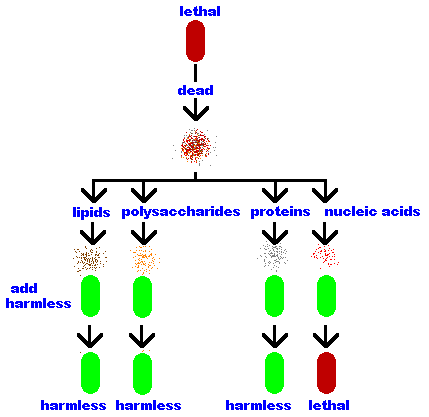 This is Avery's experiment where he's trying to prove that DNA is the transforming materical by eliminating Lipids, Polysacchardies, and Proteins.
This is Avery's experiment where he's trying to prove that DNA is the transforming materical by eliminating Lipids, Polysacchardies, and Proteins.
Chargaff 1950
Finding #1: Ratio of purines (2x ring) to pyrimidines (1x ring) = 1
Finding #2: The ratio of A to T equals one and the ratio of C to G equals 1
Finding #3: Ratios of A/T to G/C is different for different species
The A and G are purines and The G and C are pyrimidines.
All Comes Down To A=T and C=G
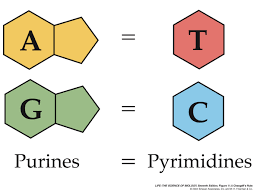
*Diagram of Chargaff's Findings
Hershey and Chase 1952 (blender experiment)
Alfred Hershey and Martha Chase studied the biological system and wanted to know if genes were made up of proteins or DNA. They conducted various experiments that were aimed at confirming whether or not DNA was the genetic material. To conduct their expiriment they used a virus because of its simplicity - there was a very simple structure with no interference from organelles like in a cell. They used T2 bacteria from the sewers of Paris and E. Coli. They found that protein never could enter the bacteria. Upon testing the E. Coli, they found that the DNA could in fact enter, and there was radioactivity in the virus pellet. It was confirmed from this expiriment that DNA is responsible for genetic information.
- confirms that DNA is the transforming/genetic material


*picture of Hersey and Chase This experiment is also known as the "blender" experiment
Franklin and Wikes 1952
- x-ray crystallography image of DNA
- A regularly-shaped crystal will dispense x-rays in regular pattern
- then math and experience allows experts to deduce structure

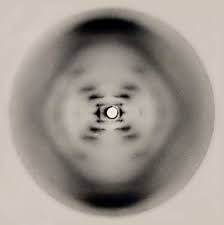
*Fanklin *Franklin's Findings
Franklin then brought her findings to Watson and Crick, who she heard were trying to build their own model of DNA. Unpublished drafts of her papers that have been examined now show that she indeed did discover the B-form of the DNA helix, which supported Watson and Crick's hypothesis. After discovering this, she went on to start pioneering work on the tobacco mosaic and polio viruses, but died at age 37 from complications of ovarian cancer.
Watson and Crick 1953
Watson and Crick were trying to build a model of DNA by not doing their own expirimentation, but using the findings out other scientists and testing models to see if they were plausible. They were inspired by one scientist Linus Pauling who had created the first helical structure which he used his imagination along with molecular models to create the structure of this protein. Their model however was mostly based off of Franklin's findings. They received a Nobel Prize for their work, but Franklin did not because she was dead by the time they were awarded. Watson and Crick's famous quote is, "It hasn't escaped our notice that the specific pairing we have postulated immediately suggests a possible copying mechanism for genetic material."
- Put it all together and built the first model

Watson and Crick with their DNA model
One hundred years prior to Watson and Crick's first model of DNA, a perfect model was inadvertently built in New Mexico inside the Loretta Chapel. The chapel was built to attract more immigrants from the east coast to settle in New Mexico. The original architect hired to build it died before its completion, and no one could figured out how to construct stairs from the very high up loft. The legend is that a barefoot, unidentified man on a donkey volunteered to build the staircase under the condition that he could work and night and nobody could watch him do it. He completed a spiral staircase and left without pay or identification. It also had no nails or screws, and was had the exact ratio and proportions of Watson and Crick's model to be created 100 years later.
 This is a picture of the Loretta Chapel's staircase with a perfectly proportional demensions of the double helix DNA shape.
This is a picture of the Loretta Chapel's staircase with a perfectly proportional demensions of the double helix DNA shape.
James Watson Bio
James D. Watson was born April 6, 1928 in Chicago, Illinois
Watson enrolled at the University of Chicago at the age of 15
After reading the book What is Life he changed his field of studies from ornithology to genetics
In 1947 he earned a B.S. in zoology from the University of Chicago
In 1950 he earned a PhD from Indiana Univeristy
He is best known for the "discovery" of the DNA model with Francis Crick
He worked at Havard University from 1958 until 1976
He recieved the Nobel Prize along with Crick and Wilkins for thier discovery in 1962
In 1968 the wrote the book The Double Helix which discribed his discovery and the conflict and controversy that went along with it
In 1989 Watson was appointed as the Head of the Human Genome Project at the National Institue of Health, he held the position until 1992
Watson Then Watson Now


Francis Crick
Crick was born June 8, 1916 in Northhamptonshire, England
While Crick was also a molecular biologist, physicist, and neuroscientis, he is most noted for his discovery of the DNA molecule with Watson
Even at an early age Crick was interested in science and books about science
Crick earned a B.S. in physics when he was 21 from University College of London
Crick earned a PhD from Caius College
During World War II he worked at Admiralty Research Labratory
After World War II he started doing more work dealing with biology
He died in 2004 of colon cancer
Crick Then Crick in 2004



Video of Watson and Crick talking about how they discovered the DNA model. It is from a 1974 documentary.
This website offers a great quiz on the history of DNA
http://www.syvum.com/cgi/online/mult.cgi/squizzes/biology/dna/BioOne.tdf?0
This belongs in DNA replication Mr F 12/10
Okazaki Fragments
An okazaki fragment is a relatively short fragment of DNA created on the lagging strand during DNA replication. The lengths of Okazaki fragments are between 1,000 to 2,000 nucleotides long and are generally between 100 to 200 nucleotides long in eukaryotes. It was originally discovered in 1968 by Reiji Okazaki and Tsuneko Okazaki and their colleagues whlile studying replication of bacteriophage DNA. When the lagging strand is being replicated on the original strand, the 5'-3' pattern must be used; thus a small discontinuity occurs and an Okazaki fragment forms. These fragments are processed by the replication machinery to produce a continuous strand of DNA and hence a complete daughter DNA helix.
Here is a picture of how Okazaki fragments differ from the leading strand.

When DNA replicates, it is immediatly replaced as the leading and lagging strands duplicate whatever piece of the sequence is needed. when the the lagging strand which moves away from the area not yet seperated (letter d in the diagram), there is no room to just replace chain in a continous manner, like done with the leading strand. This is why the lagging strand uses Okazaki Fragments which replicate DNA in short fragments to accomodate the lack of space in the DNA replication process (letter C). The diagram below shows the replication process occuring and how Okazaki Fragments are put inserted in short sections, or fragments.
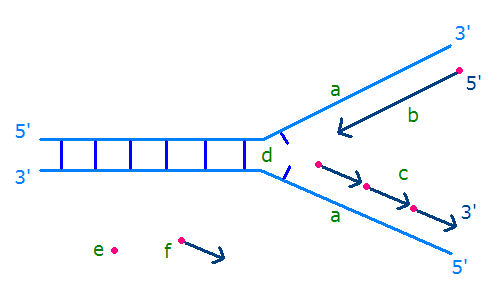

Watson and Crick are credited with modeling the first DNA sequence after seeing the model created by Franklin. Although the whole concept of DNA may not be their idea, they did in fact construct a model which accuratly displays the construction of DNA as a whole.
In 1959, Arthur Kornberg won the Nobel Price for Physiology or Medicine for his discovery of the critical enzyme that synthesizes deoxyribonucleic acid. He was extremely interested in enzymes having to do with DNA, and was the Executive Head of the Department of Biochemistry at Stanford University when he became the first person to isolate a DNA polymerizing enzyme, known as DNA polymerase I. This is what won him the Nobel Prize.
 This is a photo of Arthur Kornberg at the time of his research that resulted in his discovery of DNA polymerase I.
This is a photo of Arthur Kornberg at the time of his research that resulted in his discovery of DNA polymerase I.
In 2006, Arthur Korberg's son, Robert Kornberg won a Nobel Prize as well, one year before his father's death. His Nobel Prize in Chemistry was awarded for his research on the process of genetic information from DNA being copied to RNA. More specifically, he discovered the nucleosome, and also studied DNA polymerase III. He is a biochemistry professor at the Stanford University School of Medicine.
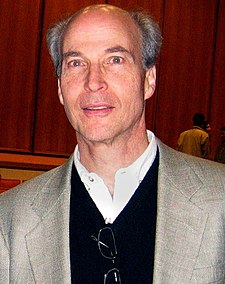 This is a photo of Roger Kornberg around the time of his Nobel Prize award in 2006 for his work on DNA.
This is a photo of Roger Kornberg around the time of his Nobel Prize award in 2006 for his work on DNA.
This website shows a very easy to understand timeline, from the first discovery of DNA all of its uses and technological advances it has made.
http://homepage.smc.edu/HGP/history.htm
Comments (1)
Charles Forstbauer said
at 2:01 pm on Dec 7, 2009
Do not put info in comments. Mr F
You don't have permission to comment on this page.